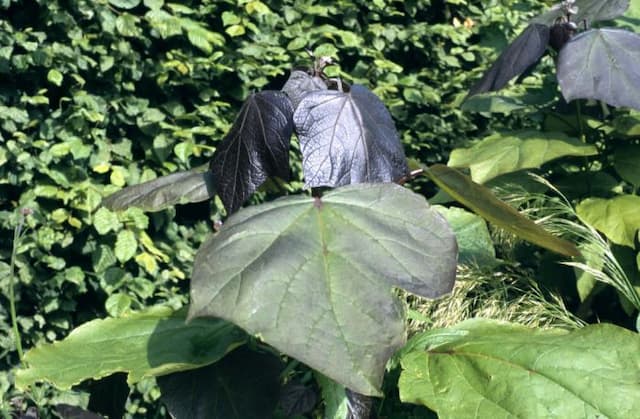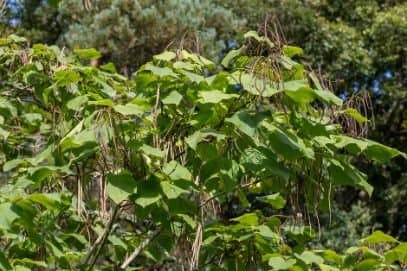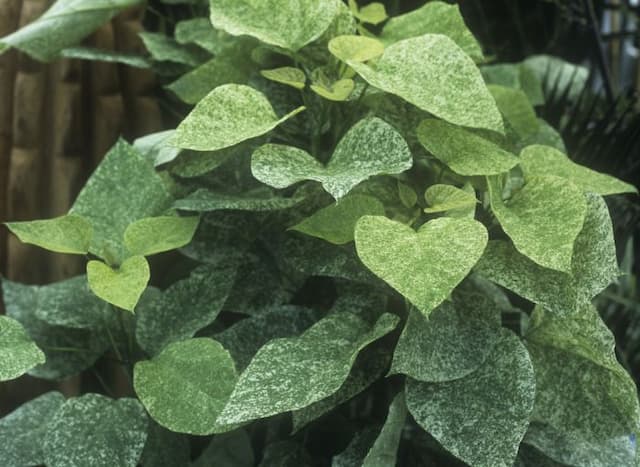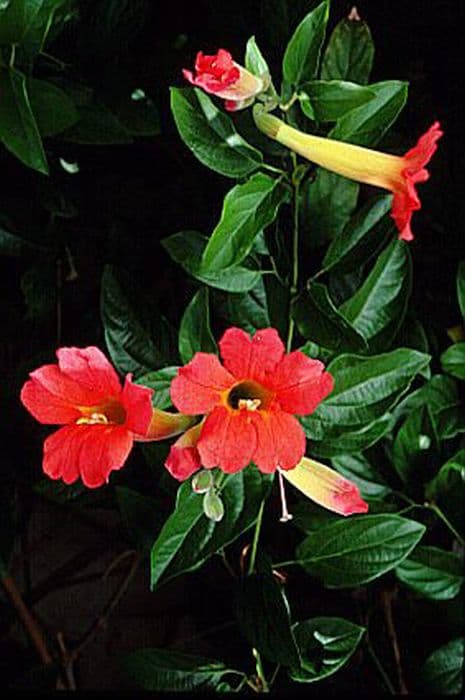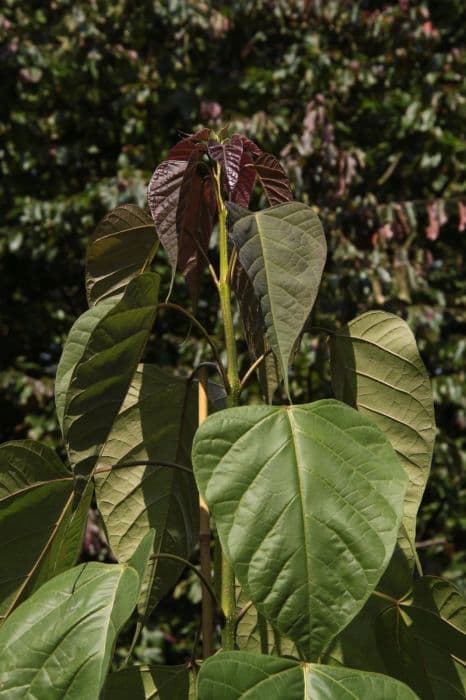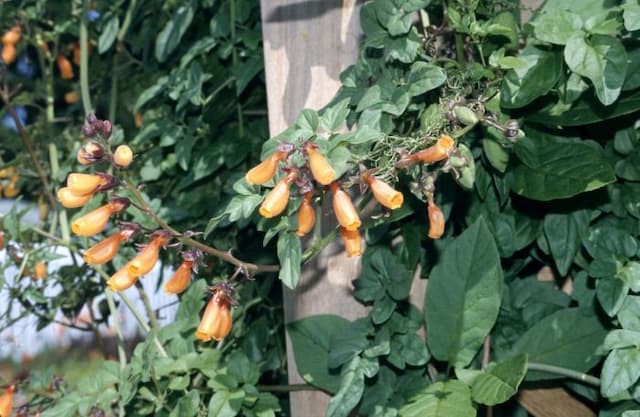Northern Catalpa Catalpa speciosa

ABOUT
The northern catalpa is a deciduous tree which is known for its striking appearance during various seasons of the year. In spring, it's recognized by its abundant white flowers that tend to bloom in large clusters. These blossoms are trumpet-shaped, which gives the tree a very ornamental look. Apart from its flowers, the northern catalpa also has large, heart-shaped leaves that provide a dense canopy of green foliage throughout the summer. When it comes to seed production, the northern catalpa is quite distinctive with its long, slender, bean-like pods, which persist through the winter and can dangle from the branches, giving the tree a unique profile even after the leaves have fallen. These seedpods also contribute to its unique aesthetic, as they can remain on the tree for quite some time even after the seeds have been dispersed. Additionally, its bark is rather ridged and furrowed, offering a textured, grey surface that is typical of more mature specimens.
About this plant
 Names
NamesFamily
Bignoniaceae.
Synonyms
Northern Catalpa, Hardy Catalpa, Western Catalpa, Catawba, Cigar Tree, Indian Bean Tree.
Common names
Catalpa speciosa.
 Toxicity
ToxicityTo humans
The Northern Catalpa is not typically considered highly toxic to humans. However, like many plants, it may cause mild stomach upset if ingested in significant quantities. There are no widespread reports of severe poisoning from this tree. While the tree itself is not highly toxic, it is still not advisable to consume any parts of it, as individual sensitivity can vary, and it is not intended for human consumption.
To pets
The Northern Catalpa is generally not considered very toxic to pets either. However, as with humans, consumption of parts of this tree, such as leaves or seed pods, can potentially cause mild gastrointestinal upset in some animals. If a pet ingests a large amount of the tree's material and symptoms like vomiting or diarrhea occur, it is recommended to consult a veterinarian. But there are no severe toxic effects commonly associated with the Northern Catalpa in pets.
 Characteristics
CharacteristicsLife cycle
Perennials
Foliage type
Deciduous
Color of leaves
Green
Flower color
White
Height
50-60 feet (15.24-18.29 meters)
Spread
20-40 feet (6.10-12.20 meters)
Plant type
Tree
Hardiness zones
4-8
Native area
North America
Benefits
 General Benefits
General Benefits- Shade Provider: Catalpa speciosa, commonly known as the Northern Catalpa, has a broad canopy that offers ample shade in landscapes and public spaces.
- Ornamental Value: With its large, heart-shaped leaves and showy, white flowers, the Northern Catalpa is planted for its decorative appeal.
- Habitat for Wildlife: The tree's flowers provide nectar for bees, while its seeds are food for various bird species.
- Timber Use: The wood of the Northern Catalpa is lightweight and resistant to rot, making it suitable for outdoor furniture, posts, and rails.
- Recreational Shade: Often planted in parks and recreational areas, the Northern Catalpa offers a cool resting spot for visitors.
- Urban Tolerant: The Northern Catalpa is tolerant of urban pollution and soil compaction, making it a good choice for city planting.
- Erosion Control: With its extensive root system, the Northern Catalpa is effective in stabilizing soil and preventing erosion.
 Medical Properties
Medical PropertiesThis plant is not used for medical purposes.
 Air-purifying Qualities
Air-purifying QualitiesThis plant is not specifically known for air purifying qualities.
 Other Uses
Other Uses- Catalpa speciosa wood is often used in woodworking for items like small boxes or novelty items, as its pale yellowish wood finishes nicely.
- The large heart-shaped leaves of the Catalpa tree are sometimes used by gardeners as a natural mulch to help retain soil moisture.
- Fishing enthusiasts sometimes use the Catalpa's long seed pods as makeshift bobbers or floats.
- Native Americans once used the Catalpa tree's seed fibers to stuff mattresses and other bedding.
- The tree's broad leaves offer a rapid shading solution for newly established parks or landscapes where quick growth is desired.
- Catalpa trees are occasionally planted as part of beekeeping operations due to their abundant flowers that are rich in nectar.
- The durable wood is used in cabinet making, although it is not as commonly sought after as other hardwoods.
- In some rural areas, the Catalpa tree's straight trunk has been used as fence posts with natural resistance to rot.
- The Catalpa's large leaves can serve as impromptu water containers or as wraps for cooking food over a fire in survival situations.
- Catalpa trees can be used in educational settings for leaf and seed pod collections due to their distinctive appearance.
Interesting Facts
 Feng Shui
Feng ShuiThe Northern Catalpa is not used in Feng Shui practice.
 Zodiac Sign Compitability
Zodiac Sign CompitabilityThe Northern Catalpa is not used in astrology practice.
 Plant Symbolism
Plant Symbolism- Longevity - The Catalpa speciosa, commonly known as the Northern Catalpa, can live for many years, making it a symbol of endurance and long life.
- Resilience - With its ability to thrive in various soil conditions and withstand strong winds, the Northern Catalpa represents resilience and adaptability.
- Beauty - The tree's showy, white flowers that bloom in the spring are seen as symbols of beauty and aesthetic appreciation.
- Protection - Historically, the Northern Catalpa has been planted to provide shade and shelter, symbolizing protection and care.
- Generosity - The ample shade and the large leaves of the Northern Catalpa signify generosity, providing comfort and rest to those in its vicinity.
- Uniqueness - With its distinct, large heart-shaped leaves and bean-like seed pods, the Northern Catalpa is often associated with individuality and standing out.
 Water
WaterThe Northern Catalpa, or Catalpa speciosa, should be watered deeply and infrequently to encourage a strong root system. In general, this means watering the tree once a week with about 1.5 to 2 inches of water, which translates to approximately 20 to 30 gallons for a young tree. Mature Northern Catalpas may need less frequent watering, depending on rainfall and soil conditions. During hot, dry spells, the watering frequency should be increased to prevent stress. It’s essential to ensure the water penetrates deeply into the soil without causing standing water around the base of the tree.
 Light
LightNorthern Catalpa trees favor full sun to partial shade conditions. They perform best in a location where they receive at least six hours of direct sunlight each day. Ensure to plant them in a place that's not shadowed by taller trees or buildings to allow them to thrive and produce their characteristic large leaves and showy flowers.
 Temperature
TemperatureThe Northern Catalpa is hardy and can withstand a range of temperatures; it can survive minimum winter temperatures down to about -20 to -30 degrees Fahrenheit. The ideal temperature for the Northern Catalpa to flourish is between 60 and 80 degrees Fahrenheit. These trees are well adapted to the climate variations typical of the central and eastern United States, making them quite resilient in varying thermal conditions.
 Pruning
PruningPruning the Northern Catalpa is mainly for aesthetic purposes and to remove any damaged or diseased limbs. The best time for pruning is late winter or early spring before new growth starts. Prune every few years to shape the tree and maintain its health by removing crossed branches and opening up the canopy for better air circulation.
 Cleaning
CleaningAs needed
 Soil
SoilThe Northern Catalpa thrives in moist, fertile, well-drained soil with a mix of loam, sand, and clay. The best pH range for this tree is between 5.5 and 7.0. A blend incorporating organic matter such as compost or well-rotted manure can enhance growth and health.
 Repotting
RepottingNorthern Catalpa trees grown in containers should be repotted every 2 to 3 years to replenish the soil and provide room for root growth. However, once established in the ground, repotting is not necessary.
 Humidity & Misting
Humidity & MistingNorthern Catalpa is tolerant of different humidity levels and does not require any specific humidity conditions for growth, as long as other cultural requirements are met.
 Suitable locations
Suitable locationsIndoor
Catalpa speciosa is not suitable for indoor growth due to its size.
Outdoor
Plant in full sun, ensure moist, well-drained soil, and space widely.
Hardiness zone
4-8 USDA
 Life cycle
Life cycleThe Northern Catalpa (Catalpa speciosa) starts its life as a seed, often dispersed by wind due to its lightweight and wing-like structure. Germination occurs when conditions are favorable—usually in moist, well-drained soil with adequate warmth. The seedling develops into a young sapling, which gradually establishes a deep taproot and begins to grow its characteristic large, heart-shaped leaves. As the sapling matures into a tree, it develops a sturdy trunk and an extensive branch system; after several years, it begins to produce clusters of white, trumpet-shaped flowers each spring, which are followed by long, slender seed pods. These pods persist through winter and release their seeds the following spring, thus continuing the reproductive cycle. The Northern Catalpa can live for many decades, often well over 50 years, enduring through the cycle of flowering, seed production, and senescence, where older trees eventually decline in vitality and die.
 Propogation
PropogationPropogation time
Spring to early summer
The Northern Catalpa, scientifically known as Catalpa speciosa, is commonly propagated through seed. In late winter or early spring, the seeds, which are encased in long, slender pods, can be collected and sown immediately or stored and stratified for later planting. Stratification, a process of cold treating the seeds to break dormancy, involves mixing the seeds with slightly moist sand and placing them in a sealed plastic bag in the refrigerator for 60 to 90 days. Once stratified, the seeds are sown in a well-drained seed starting mix, barely covered with soil, and kept consistently moist until germination, which typically occurs in one to three weeks. Seedlings require ample sunlight and should be grown in pots until they are strong enough to be transplanted outdoors. This method of propagation from seed allows for genetic variation among the seedlings, which may result in diverse characteristics within the offspring.
